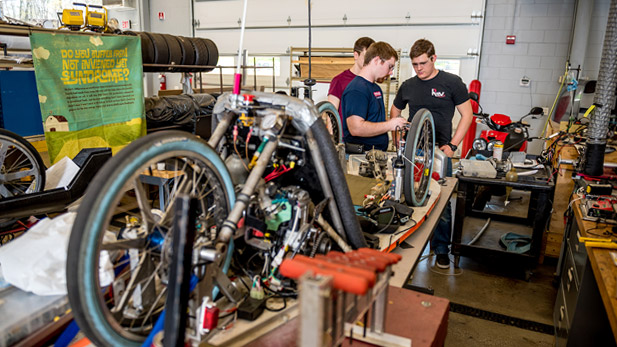Efficient Vehicle Team Focuses On Time Management

The Rose-Hulman Efficient Vehicle team designs and builds an ultra-energy-efficient vehicle for the Shell Eco-marathon series.
On the surface, engineering may seem to be all about figuring things out and making them work. As the Rose-Hulman Efficient Vehicle team (RHEV) has learned, there’s a lot more to it. Another set of professional skills come into play—things like teamwork, project management and communication.
Then there’s the need to roll with the punches, adapt to changing situations and work it out on the fly. Competitions such as the Shell Eco-marathon Americas event (April 19-22 in Sonoma, California) provide real-world, real-time experience to complement classroom learning.
At this year’s Eco-marathon, the team considered it a victory to pass technical inspection. Though on-track competition gets more attention, the inspection is the first and biggest hurdle the teams face. “Technical inspection is the hardest part, because they have to inspect your vehicle to make sure it meets criteria for all the subsystems,” says Christian Smith, who will be a junior and team president this fall. “Not everything satisfied the inspectors’ interpretation of the rules, so we ended up improvising solutions. It was a lot of rapid redesigning of the vehicle. We ended up passing inspection, which was a big achievement for us this year.”
Smith plans to attract and retain a diverse, committed crew. His job as president entails managing the sub-teams to coordinate the overall effort and keep it on track. “We have biomedical engineering [majors], mechanical engineering, electrical engineering, computer science…Whatever you’re interested in working on, we let you work on it,” Smith says.
Starting early and keeping deadlines will allow more time before competition to test and tweak the vehicle. That also means more time for the driver (Arisa Kouchi—whose senior year will be her third as driver for the RHEV team) to get comfortable with the vehicle and help dial it in for best results.
Looking ahead, Smith envisions developing a platform (basics such as body and steering systems) that could house either an internal-combustion engine such as the team uses now or an electric drive system.

